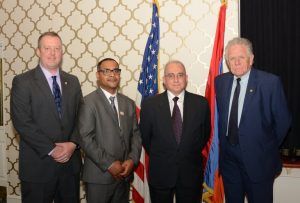The Armenian Genocide and Diaspora on Film

The Armenian Genocide was one of the early 20th century’s first crimes against humanity that would be documented photographically by image-makers within the borders of the waning Ottoman Empire, and later in Hollywood. This presentation highlights key historical parallels between the genesis of photographic and motion picture technology, its critical role in the visual documentation and presentation of the Armenian Genocide, and the aftereffects across the 20th century in mainstream media and Diaspora communities worldwide. Between 1895 and 1915, the motion picture industry bloomed across Europe and the United States, ushering in a revolutionary new era of image making that would lead to the birth of Hollywood and the world film industry.
This period also witnessed the decline of the Ottoman Empire in tandem with the beginning of the 20th century’s First World War. The rapidly advancing evolution of motion picture technology spread across the United States and Europe as a new generation of image-makers started documenting the world visually. During this period, one survivor, Aurora Mardiganian from Kharpert would survive the Genocide and flee to New York with the aid of the Near East Relief. Her autobiography was turned into the feature film, Ravished Armenia (Auction of Souls) that became the first silent film about the Armenian Genocide in Hollywood.
The film’s commercial success in 1919 drew increasing attention to the deportations and massacres of the Armenians as well as a means of exploiting tragedy for entertainment value. Celluloid Exiles & Matinee Idols explores the early images and first mainstream movie about Armenians and the immediate and long-term influence of cinema on the public consciousness and perception of Armenians during the First World War and generations later as depicted in cinema and pop culture.
Eric Nazarian, a Screenwriter-Director-Producer, is Born in Armenia and raised in Los Angeles, he holds a Bachelor of Arts in Film Production from the University of Southern California’s School of Cinematic Arts. The Blue Hour, his first feature film, world premiered at the 55th San Sebastian International Film Festival, winning several awards on the international film festival circuit. In 2008, Eric received the Academy of Motion Picture Arts and Sciences® Nicholl Fellowship in Screenwriting for his screenplay, Giants. In 2010, he made Bolis, a short film about a descendant of a Genocide survivor in Istanbul as part of the EU’s Capital of Culture Program. Nazarian is working on the film adaptation of The Sandcastle Girls, Chris Bohjalian’s critically acclaimed bestselling novel. He has lectured on the origins of cinema and the Armenian Genocide in campuses across the U.S. and Europe. He is a member of the Writers Guild of America West and a Fellow of the USC Institute of Armenian Studies.




 Արևելահայերեն
Արևելահայերեն Արևմտահայերեն
Արևմտահայերեն Русский
Русский






